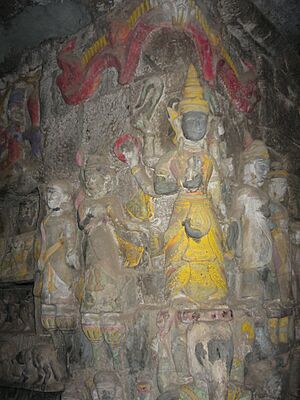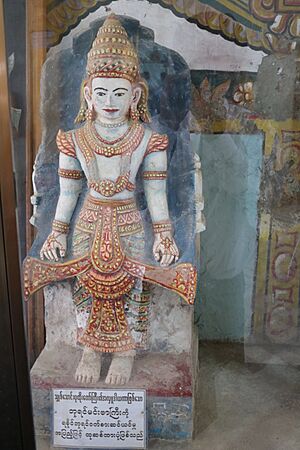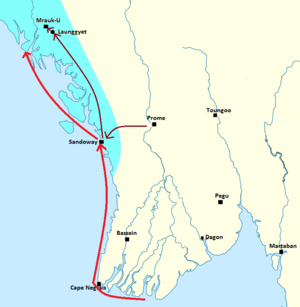Min Bin facts for kids
Quick facts for kids Min Binမင်းပင် Zabuk Shah (ဇာပေါက်သျှာ) |
|||||
|---|---|---|---|---|---|

Min Bin, depicted as a god, in the Shitthaung Temple, Mrauk U
|
|||||
| King of Arakan | |||||
| Reign | 27 May 1531 – 11 January 1554 | ||||
| Coronation | 16 September 1531 | ||||
| Predecessor | Minkhaung | ||||
| Successor | Dikkha | ||||
| Born | c. February 1493 Saturday, c. Tabaung 854 ME Mrauk-U |
||||
| Died | 11 January 1554 (aged 60) Thursday, 8th waning of Tabodwe 915 ME Mrauk-U |
||||
| Burial | Shitthaung Temple | ||||
| Consort | Saw Min Hla Saw Kauk Ma II Minkhaung Medaw Saw Mae Kyi Saw Shin |
||||
| Issue | 10 children including Min Dikkha and Min Phalaung | ||||
|
|||||
| Father | Raza | ||||
| Mother | Saw Nandi | ||||
| Religion | Theravada Buddhism | ||||
Min Bin (born 1493, died 1554) was a powerful king of the Arakan region. He ruled from 1531 to 1554. During his time, Arakan became a very important and strong country.
King Min Bin used soldiers from Portugal and their guns to make his army and navy strong. His forces expanded the kingdom's borders deep into Bengal. He even had coins made there with his name on them. He also got involved in the politics of mainland Burma.
After winning battles against Bengal and Tripura (1532–1534), Min Bin saw himself as a "world conqueror." To celebrate his victory in Bengal, he built the Shitthaung Temple. This is one of the most famous Buddhist temples in Mrauk-U. However, his plans to expand faced challenges. His control over Bengal was not always strong. Also, he struggled with raids from the Tripuri people.
Later, his involvement in Lower Burma led to attacks from the Toungoo kingdom. These attacks almost ended his rule. But he survived and even helped the Ava Kingdom to stop Toungoo's advance.
King Min Bin passed away in January 1554. His oldest son, Min Dikkha, became the next king. Min Bin's legacy was important. The strong defenses he built protected Arakan from another Toungoo invasion for many years. He also created a powerful navy that ruled the Bay of Bengal. This helped Arakan control a long coastline for a long time. His 22-year rule made Mrauk-U a major power in the region.
Contents
Early Life of Min Bin
Min Bin was born in 1493. His birth name was Min Pa. His father was Crown Prince Min Raza of Mrauk-U. His mother was Princess Saw Nandi. His parents were cousins. His mother was the daughter of his father's uncle.
Min Pa had a younger brother named Min Aung Hla. He also had many half-siblings. In 1502, his grandfather, King Salingathu, died. His father then became king. His father took three new queens, and his mother became a less important queen. A few years later, Min Pa was made a general in the army.
How Min Bin Became King
In 1513, Min Pa's father was overthrown by another son, Gazapati. Even though Min Pa was older and had a stronger claim to the throne, he stayed out of the conflicts. He managed to survive the power struggles at court. During this time, three different kings ruled in eight years.
In 1521, King Thazata died. His younger brother, Minkhaung of Mrauk-U, became king. Min Pa did not get the throne. However, he was appointed governor of Thandwe (Sandoway). This was the second most important city in the kingdom.
At Thandwe, Min Pa slowly built a group of loyal followers. He also gathered weapons. Ten years later, he started a revolt. He marched to Mrauk-U with his army and navy. His forces defeated the king's army. Min Pa then had Minkhaung executed.
Min Bin's Rule as King
Securing His Power
Min Bin became king on May 27, 1531. He took the royal names Thiri Thuriya Sanda Maha Dhamma Yaza and Zabuk Shah. Since he took power by force, the new king immediately ordered the defenses of Mrauk-U to be strengthened.
Over the next ten years, the capital city of Mrauk-U got strong defenses. These included huge stone walls and a deep moat filled with water. These defenses were later built in other parts of the kingdom. This was because Portuguese pirates often attacked the coastal areas after 1532.
Min Bin also worked to make his rule secure. He faced no opposition. Lords from all over the kingdom came to promise their loyalty. This happened at his coronation ceremony on September 16, 1531.
One important area, Chittagong, did not send tribute. Chittagong had paid tribute to earlier strong Arakanese kings. Min Bin wanted to get back what he believed was his kingdom's rightful land. He believed this included all of Bengal, not just Chittagong.
Taking Control of Bengal (1532–1533)
Min Bin claimed that all of Bengal belonged to ancient Arakanese kingdoms. This claim might not have been true. But he used it as a reason to attack Bengal. Bengal was weak at the time due to its own wars.
On October 7, 1532, Min Bin led an invasion force of 12,000 soldiers. They attacked Bengal. His forces defeated the Bengal army and took Chittagong. The armies then moved towards Dhaka.
The Bengal army made a final stand outside Dhaka but was defeated. Arakanese forces entered Dhaka on December 11, 1532, without a fight. In Dhaka, on February 8, 1533, local lords of Bengal paid tribute to Min Bin. He also made a 16-year-old princess from Bengal royalty his queen. He then went on a religious trip to Bodh Gaya. He left Dhaka for Mrauk-U on April 13, 1533. He appointed governors for the new lands he had taken.
Tripuri Raids
Historians say that Min Bin's control over Bengal, beyond Chittagong, was not always strong. He had to deal with raids from "Tripuri tribes" from the north. These raids happened throughout his rule, attacking Dhaka, Chittagong, and Ramu.
Within a year of taking Bengal, he had to send 5,000 soldiers to Dhaka. This was to defend against Tripuri raids. After the rainy season of 1533, he personally led the army to drive out the raiders. He succeeded and returned to Mrauk-U in February 1534.
Even with this success, Min Bin never fully solved the problem of Tripuri raids. For example, when Mrauk-U was under attack in 1547, Tripuri forces raided Chittagong and Ramu. Min Bin had to send soldiers to push them back after the Toungoo forces left.
Dealing with the Portuguese
By Min Bin's time, Portuguese sailors and soldiers were very powerful in Asia. They had taken important trading ports and controlled sea routes. The Arakanese coast was often raided by them. These raids became more daring during Min Bin's rule.
In 1535, the Portuguese even attacked the capital city of Mrauk-U. A small but well-armed group of Portuguese soldiers landed on February 22, 1535. They traveled up the Kaladan river by boat. They reached Kandaza, near Mrauk-U, by February 26. After defeating an Arakanese force, they attacked Mrauk-U on February 28.
King Min Bin himself led the defense. The Arakanese forces pushed back the smaller but better-armed Portuguese army. The Portuguese retreated but stayed nearby for another week. Then, a combined Arakanese army and navy drove them out to sea on March 7.
Like many rulers in the region, Min Bin understood that the Portuguese would not go away. He decided to hire Portuguese soldiers for his own army. In the following years, Min Bin hired many Portuguese mercenaries and used their firearms. With their help, he built strong naval and army forces.
Building Temples
After his military victories, Min Bin began to see himself as a "world conqueror." To celebrate his victory in Bengal, he started building a huge temple complex. This became the famous Shitthaung Temple (meaning 80,000 Buddha Images). Construction began on November 9, 1535.
The temple's design combined ideas from Burmese Buddhism and Indian Buddhism. It showed the king's power and his religion. He also restored the Andaw-thein Ordination Hall between 1534 and 1542.
Wars with Toungoo Kingdom
Conflict over Prome (1542)
By the late 1530s, Min Bin had made Mrauk-U a strong regional power. He controlled the entire Arakan coast up to Chittagong. He also had a powerful navy and an army with many Portuguese soldiers.
He was worried about the growing power of the Toungoo kingdom in mainland Burma. Toungoo had defeated Hanthawaddy and now controlled Lower Burma. Min Bin did not want a strong, united kingdom in the Irrawaddy valley. Such kingdoms had often interfered with Arakan in the past.
When King Minkhaung of Prome, who was an ally of the Shan States, asked for an alliance, Min Bin agreed. Prome was the only part of Lower Burma not controlled by Toungoo. In November 1541, Toungoo armies attacked Prome. Min Bin sent a 5,000-man army by land and a 7,000-man, 700-boat navy by sea to help.
However, the land army was ambushed and destroyed by a Toungoo army led by General Bayinnaung. The navy had taken Pathein but retreated after hearing about the army's defeat.
Toungoo Invasion (1545–1547)
After this setback, Min Bin strengthened the defenses of Mrauk-U and other forts. His preparations proved very useful. In October 1545, four Toungoo regiments entered southern Arakan. They marched towards Thandwe, Arakan's second city. Min Bin sent a strong force that drove out the invaders.
This attack was just a test by Toungoo. A year later, on October 28, 1546, Toungoo invaded with a much larger force by land and sea. Toungoo forces quickly took over southern Arakan. Mrauk-U's forces fought bravely but could not stop the advance.
Toungoo forces reached the area around Launggyet, the former capital near Mrauk-U, on January 23, 1547. The next day, Toungoo forces drove the Mrauk-U army from Launggyet. They then surrounded the heavily fortified Arakanese capital. They even broke through the outer defenses of Mrauk-U. But Min Bin opened the city's water gates, flooding them out.
The Toungoo king did not want a long siege. He agreed to a truce with Min Bin on January 30. Toungoo forces began to retreat three days later. They left Thandwe on March 26, 1547. After the war, Min Bin sent soldiers to drive out Tripuri raiders who were attacking Ramu and Chittagong.
Min Bin remained worried about the Toungoo threat for the rest of his rule. He sent 3,000 soldiers to help King Sithu Kyawhtin of Ava. Ava was an enemy of Toungoo, and Min Bin wanted to help put down rebellions there.
Min Bin's Government
Min Bin's oldest son, Dikkha, was the chosen heir throughout his reign. When Min Bin became king, he made his brother, Min Aung Hla, governor of Thandwe. This was the second most important city. However, he later appointed one of his sons, called Upayaza, to Thandwe.
Some historical records say that Min Aung Hla was unhappy about this. They say he sought help from Toungoo, which led to Toungoo's invasion (1545–1547). However, Arakanese records do not agree that Min Aung Hla ever betrayed his brother.
Death of Min Bin
Min Bin died on January 11, 1554. His chosen heir, Dikkha, became the next king.



